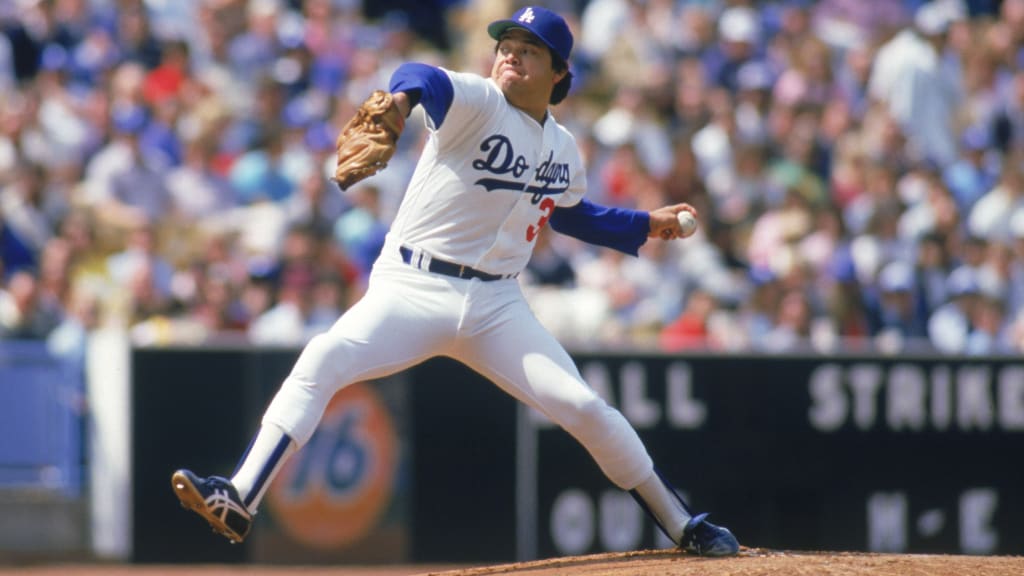
This piece originally ran in 2021 on the 40th anniversary of Fernando Valenzuela's incredible rookie season, when he became the first player to win Rookie of the Year and a Cy Young Award in the same season. It is being resurfaced in light of the news of his passing.
“I truly believe," legendary Dodgers broadcaster Jaime Jarrín once said, "that there is no other player in Major League history who created more new fans than Fernando Valenzuela. Sandy Koufax, Don Drysdale, Joe DiMaggio, even Babe Ruth did not. Fernando turned so many people from Mexico, Central America, South America into fans. He created interest in baseball among people who did not care about baseball.”
That is, of course, impossible to prove or disprove, though trust us, we're about to try.
What's important is to remember now, four decades after Fernandomania took the baseball nation by storm, is just how important it all seemed, the kind of legend that can't be obtained only through on-field greatness -- though Valenzuela surely had that -- but off-field mythmaking, too. There’s a difference between being “famous” and being a “phenomenon,” and hawkers selling a hastily assembled record full of songs about you certainly qualifies as the latter.
So yes, he may have been the 20-year-old rookie who was an emergency starter on Opening Day and then allowed only two earned runs in his first seven starts. But he was also the young lefty who looked to the sky before he threw, and had a screwball that no one else did, and dominated with a body type that didn't, then or now, exactly scream "professional athlete."
It was all of that, and it was more. Part of it was also the appeal of a Mexican-born superstar pitcher in Southern California, which Major League Baseball hadn't really had at the time. Through 1980, there had only been two Mexican-born starters in history to collect even 30 career starts. Specific to the Dodgers, they'd had just one Mexican pitcher who had ever pitched for them, a little-remembered reliever named José Peña, who saw action in 55 games from 1970-72.
"I've never seen anything like it," Jarrín said a month into the 1981 season. "[Dodger pitcher Bobby] Castillo is a Mexican-American, a Chicano who was born in Los Angeles, but it's a bigger thing to have someone from Mexico. And Fernando is from the state of Sonora, a main source of immigrants to this area. We Latins are big sports fans. We've always had sports heroes, but they've been boxers. Fernando has the potential to become king of them all."
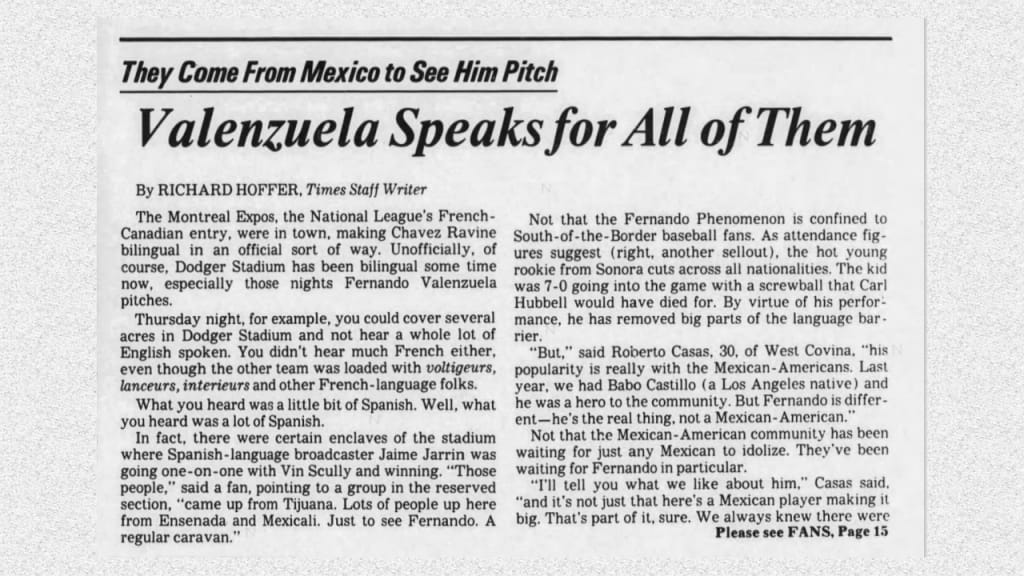
While Jarrín said that he thought no one had ever created more new fans than Valenzuela, let's take that to mean "no one had ever sold more tickets," because at least in that sense, we can try to apply some context.
We do have historical attendance numbers, and plenty of contemporary news reports. What we can do is look at that 1981 season and see how many tickets were sold to each of his starts, and how that stacks up not just against the rest of his Dodger pitching teammates -- and remember, this was a good and popular Dodger team, one that had gone to the World Series in 1977 and '78 and would win it all in '81 -- and see how it stacks up, not just within 1981 but historically.
"I've seen people standing in front of Dodger schedules," Dodger Stadium security guard Rico Rivera was quoted as saying in the May 17, 1981, edition of the San Francisco Examiner and Chronicle, "just counting -- uno, dos, tres, quatro -- then saying, 'We'll buy tickets for that game, the fifth game, because that's when he's pitching again."
"I can not recall anything like this, not for one person," said Ruth Gleason in the same article. Gleason was a telephone operator for the Dodgers who had, at the time, been working for the team for 15 years. "They're all about Fernando. Is the game televised? When does he pitch next? Is the game sold out?"
It got to the point that merely dropping a different starter from the rotation, one who hadn't lasted past the second inning in either of his two previous starts, created conspiracy theories.
"Valenzuela would have originally pitched his next game Tuesday night against the Phillies, which caused it to sell out," wrote the May 15, 1981, edition of the Los Angeles Times. "Then [manager] Tom Lasorda dropped Rick Sutcliffe from the rotation and decided to go with four starters, which moved Valenzuela to Monday. Monday's game sold out, too, but the Dodgers started receiving complaints that they had switched Valenzuela to sell tickets. The Dodger posture is that the club hadn't announced the rotation that far in advance, that if fans wanted to count ahead, they'd have to take their chances. The Dodgers are nonetheless allowing exchanges for the Tuesday tickets."
If that sounds like fans were more interested in seeing Valenzuela than his teammates ... they were. Let's prove it.
Valenzuela outdrew his 1981 teammates consistently
Valenzuela’s 25 starts came in 25 different series during the 1981 season, 12 at home and 13 on the road. We can’t just look at attendance for his starts against the rest of the National League, because the Dodgers of that era consistently outdrew everyone else anyway. (In 1980, they had 600,000 more home fans than anyone else, and they were first in 1979, and 1978, and 1977 and ... so on. It’s likely they drew more on the road than other clubs, too.)
So instead, let’s keep the team consistent and compare his starts to those of the other Dodger starters, who were primarily Burt Hooton, Jerry Reuss and Bob Welch (68 of the team’s 110 starts), and occasionally Dave Goltz, Sutcliffe, Ted Power and Castillo (17 more). Welch and Reuss had each been All-Stars the previous year, and Reuss had actually finished second to Steve Carlton in National League Cy Young Award voting. Hooton had finished second himself in 1978. They weren’t exactly nobodies.
Of the 25 different series in which Valenzuela appeared, his start sold the most tickets of the series 22 times, and two of the three times he didn’t sell the most came in early April, before it might have been fully clear what was happening. The final time, on Sept. 6 against the Cardinals, his Sunday start was outdrawn by Goltz's Friday night start by only about 1,330 fans.
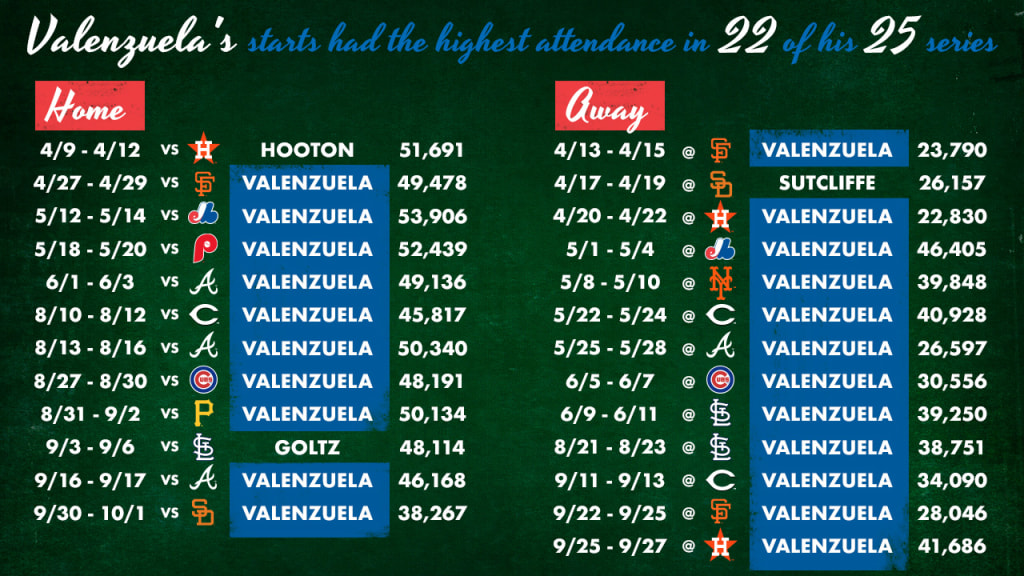
Otherwise? Every single time he pitched in a series, he drew the most fans.
He pumped up road attendance more than anyone in recent NL history
But why stop at 1981? If we can run the numbers for that year, we can do it for any year.
Valenzuela's starts drew an average of 33,273 on the road, while the remaining Dodger games drew an average of 19,456. That's a boost of 71%, and so of course, we wanted to know: Is that good? Is that great? Had anyone ever done that? So we went back to 1969, the start of divisional play, and we looked for all pitchers who made at least 10 starts both home and away during a season. There were, as you'd expect, thousands. No National Leaguer topped him. No one came close.
Of course, we're saying "National Leaguer" for a reason, because there was one American Leaguer who did him one better. In 1971, A's rookie Vida Blue won both the AL Cy Young Award and Most Valuable Player, and he had something of a Fernandomania season himself. ("Blue to Give Yankee Turnstiles A Run for Their Money Today," ran a headline in the New York Times on Aug. 15, 1971.) Blue's A's drew 28,754 on the road when he started, but 13,369 when he didn't, meaning that he more than doubled the rest of his teammates, so far as attendance goes.
In the National League, though, Valenzuela stands alone.

So perhaps we ought to be talking more about Blue, because if this is Fernandomania's 40th anniversary, well, then it's the 50th year since Blue's magical first full season. But so far as Valenzuela goes: Just about no one has done what he did.
"It's great for baseball, this Fernandomania thing," future Hall of Fame third baseman Mike Schmidt said in May 1981. We agree, and you can trace the path of how the mania began to swell as the season went on.
APRIL
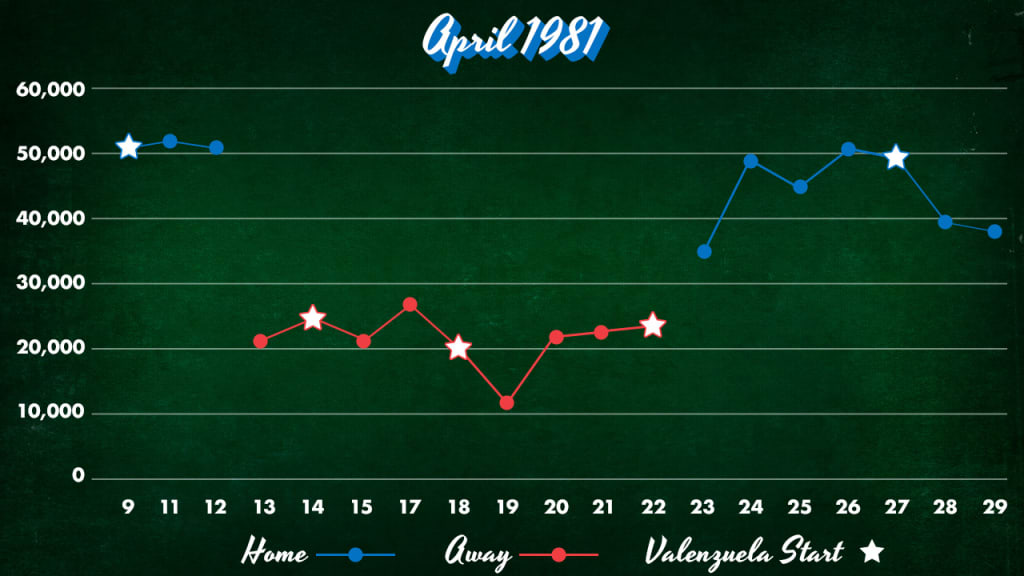
Valenzuela didn't come out of nowhere, not entirely. He entered the 1981 season already on some kind of streak, having thrown 35 consecutive scoreless innings to finish his Double-A career in 1980 and then 17 2/3 more as a Dodger reliever near the end of the year, thanks in large part to the screwball he’d picked up in the winter of 1979-80, taught to him by Castillo. Before the season even began, in late March, he was the subject of a Sports Illustrated profile.
In 1981, he was expected to slot into the middle of the rotation, but was forced into an unexpected Opening Day start -- so unexpected that he'd actually thrown batting practice the day before, which was a thing active pitchers actually used to do sometimes -- after veterans Reuss (calf) and Hooton (toe) were unable to go.
It was his first Major League start, coming on Opening Day, on almost no notice, against a Houston team that had taken the 1980 NL West by a single game over the Dodgers thanks to a 7-1 victory in a one-game tiebreaker. Valenzuela shut out the Astros 2-0 in front of 50,511 fans, though that number wasn’t out of line with the other season-opening games in Los Angeles.
The “mania,” so far as April went, started off slowly, though certainly Valenzuela did not. In his second start, on April 14 in San Francisco, he pitched a one-run complete game on a Tuesday night, mildly drawing the most fans of the series, though still a modest 23,790. It was the same in San Diego on April 18; Valenzuela pitched a shutout, though in front of just 19,776. Ditto a rematch with the Astros on April 22 in Houston; another shutout -- this time, he also drove in the only run in a 1-0 victory -- and another best-of-series ticket sale, but still, only to 22,830 in the Astrodome.
Back home in Los Angeles on April 27, Valenzuela pitched another shutout, his fourth in five tries, lowering his ERA to an unimaginable 0.20, and if you want to draw a line to where the “mania” really began, look here. On a Monday night, 49,478 showed up to watch him face the Giants. The remaining two nights of the series, started by Sutcliffe and Welch, each drew 10,000 fewer fans.
MAY
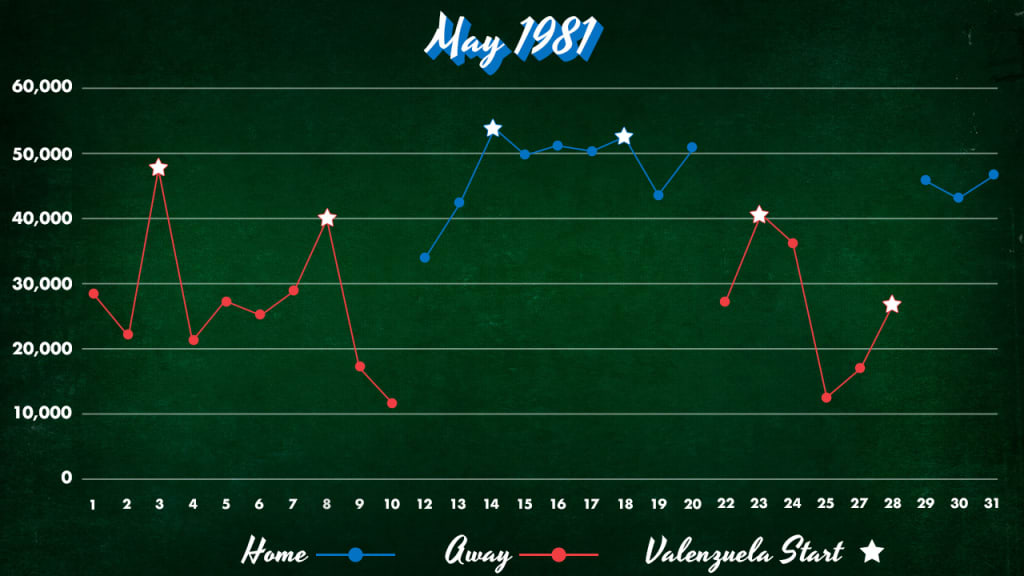
In early May, the Dodgers headed north to Canada for a four-game wraparound weekend set in Montreal against the Expos. Three of the games, the Friday, Saturday and Monday ones, drew similarly, attracting between 21,000 and 28,000 fans. But on Sunday, May 3, the Expos drew 46,405, and we don’t think they were there to see Montreal starter Bill Gullickson.
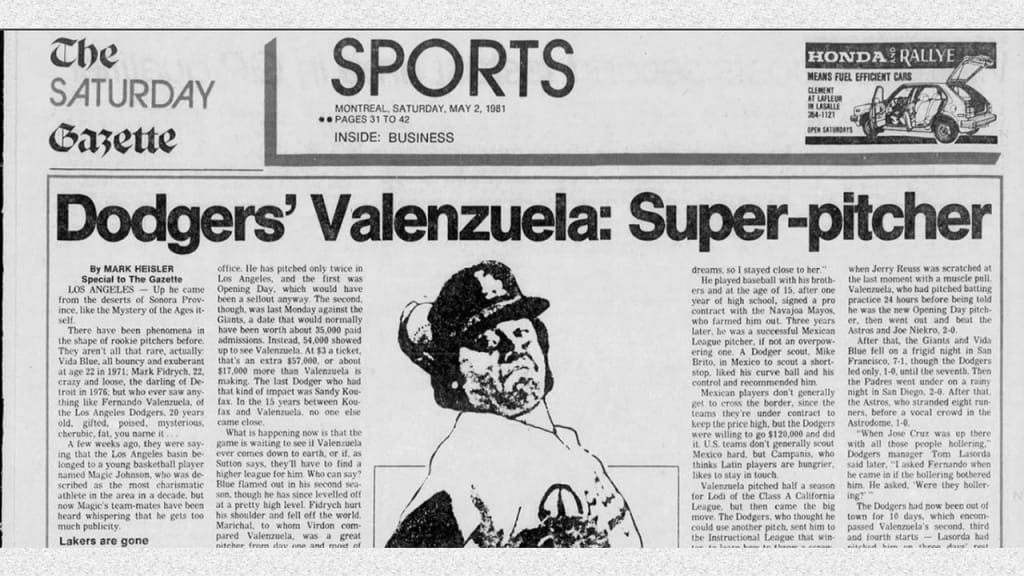
By this point, Fernandomania was in full swing. On May 4, another Sports Illustrated profile arrived. After Montreal, the Dodgers headed to New York to face the Mets, and on May 8, Valenzuela pitched another shutout, in front of 39,848 on a Friday night. This after the Mets drew all of 16,803 total fans for a three-game set against the Giants in the three days prior. The Dodgers stayed for afternoon games on Saturday and Sunday, which drew 28,878 fans … combined.
On May 14, he came back to Los Angeles and a hero’s welcome. On a Thursday night, the finale of a midweek series against Montreal, the Dodgers sold 53,906 seats, the most they had sold for a game since 1974. Valenzuela pitched a complete game for the win, and even chipped in two hits at the plate.
Four days later, on May 18, he picked up his first loss, allowing four earned runs to the Phillies in Los Angeles in front of 52,439; this game and the May 14 start were the two most highly attended games of the entire 1981 season for the Dodgers. Yet while no one could have known it at the time, this was the end of the great on-field run. Not that he was ineffective later on -- he did throw three more shutouts after May -- but through the May 14 start, he had a 0.50 ERA; from the May 18 start on, it was 3.66.

JUNE
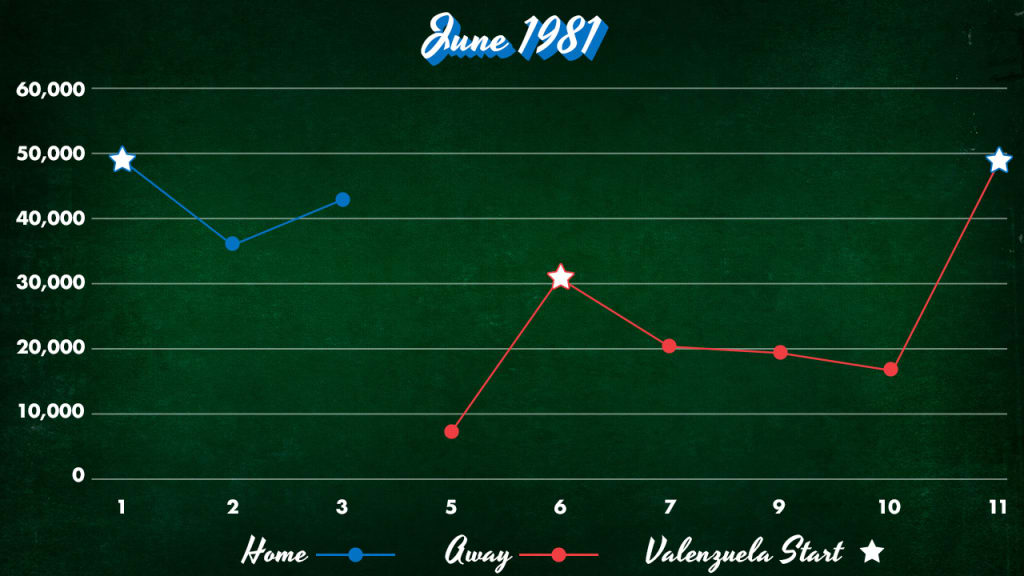
The “mania” remained in full swing here, as a return home on Monday, June 1, against the Braves drew 49,136 -- far more than either of the next two games against Atlanta -- and his first trip to Wrigley Field on June 6 attracted 30,556, a hilarious number considering that the previous day, a celebrated Friday afternoon game in Chicago, drew all of 7,815 for a Reuss start. (It appears to have been a warm, dry day, too.)
In St. Louis on June 11, after only 19,654 had shown up on Tuesday and 17,779 on Wednesday, 39,250 came to watch him pitch. It was the second-largest crowd at Busch Stadium all year. The day before, he'd been in Washington for an engagement at the White House. The headline of that event, lest we think his attendance-drawing powers were limited to baseball fans, tells the story: "Valenzuela draws crowd at White House luncheon."
And then, everything stopped. On June 12, the players went on strike. The season wouldn’t resume for nearly two months.
AUGUST

Valenzuela started the second game of the restarted season, and the momentum hadn’t subsided. In each of his four August starts, he drew considerably more fans than any other game in the series. It’s not hard to see the effect immediately, really. The first game of the second half was Monday, Aug. 10, against the Reds, started by Reuss, and 35,120 came to see the return of baseball. The third game was Wednesday, Aug. 12, and 36,494 showed up to see Tom Seaver battle Welch. The middle game, on Aug. 11, had Valenzuela. There were 45,817 tickets sold.
On, really, it went. The end of that homestand was a four-game set against the Braves, and attendance went like this: 27,418 (Aug. 13, Hooton); 35,592 (Aug. 14, Goltz); 40,510 (Aug. 15, Reuss), and then, for Valenzuela’s start on Aug. 16: 50,340. They went on the road to Chicago, where he didn’t pitch, and then attracted 38,751 to St. Louis for his start on Saturday, Aug. 22, a day before the same two teams drew only 18,189. In fact, the next four games after his Aug. 22 start (the finale in St. Louis and a three-game set in Pittsburgh) all drew fewer than 20,000 fans.
Back in Los Angeles on Aug. 27, Valenzuela shut out the Cubs in front of 48,191 for a 7:35 p.m. start, once again the highest draw of the series. His next start came in the middle of a midweek series against the Pirates, and it might have been the best example of Fernando-mania all season long.
SEPTEMBER / OCTOBER
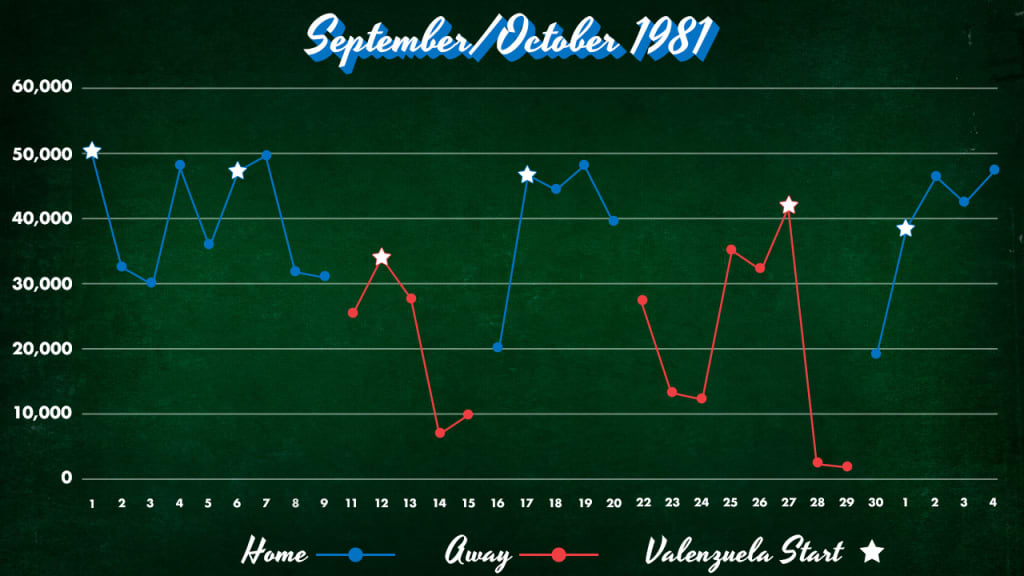
Here’s how that Pirates series looked, and it really tells the story of the entire season.
Monday, Aug. 31: 35,862 (Reuss)
Tuesday, Sept. 1: 50,134 (Valenzuela)
Wednesday, Sept. 2: 32,027 (Welch)
On Sept. 6, Valenzuela shut out the Cardinals in front of 46,780, though for the first time since April, it wasn’t the highest draw of the series; two days earlier, a Goltz start on a Friday night had attracted 48,114. The rest of the season continued apace; his Sept. 12 start in Cincinnati (34,090) sold about 30% more tickets than the days before and after it. His Sept. 17 start back home against the Braves drew 46,168 on a Thursday night, a day after only 19,905 filled Dodger Stadium to see Reuss battle Atlanta. They were rewarded with Valenzuela's final shutout of the year.
One last road trip drew two more large crowds. An audience of 28,046 saw him start on Tuesday, Sept. 22 in San Francisco, which may not sound like a lot until you realize the next two nights combined drew 25,784. In Houston on Sept. 27, there were 41,686, the third-biggest Astros home crowd of the year, and over 9,000 more than had come to see Nolan Ryan pitch the day before.
Finally, back home in Dodger Stadium, Valenzuela started against the Padres on Oct. 1. It was a Thursday, and 38,267 came to see him. It was almost exactly twice as many fans as had filled the park the day before to see Hooton against San Diego.
All told, Fernandomania looked like this:
At home, his starts drew 48,431, while non-Fernando starts drew 40,941.
On the road, his starts drew 33,237, while non-Fernando starts drew 19,456.
It wasn’t about the day of the week, really; somehow, Valenzuela only had two weekend (Friday/Saturday/Sunday) starts at home, and they didn’t draw much differently than his mid-week starts did. It was about the phenomenon, the sense that you had to be there to see it.
Jarrín said he thought no one had ever created more fans, and we’ll never know. But in 1981, Valenzuela absolutely drew more fans by himself than almost anyone else ever had. It’s as close to a baseball "mania" as you’ll ever get.



